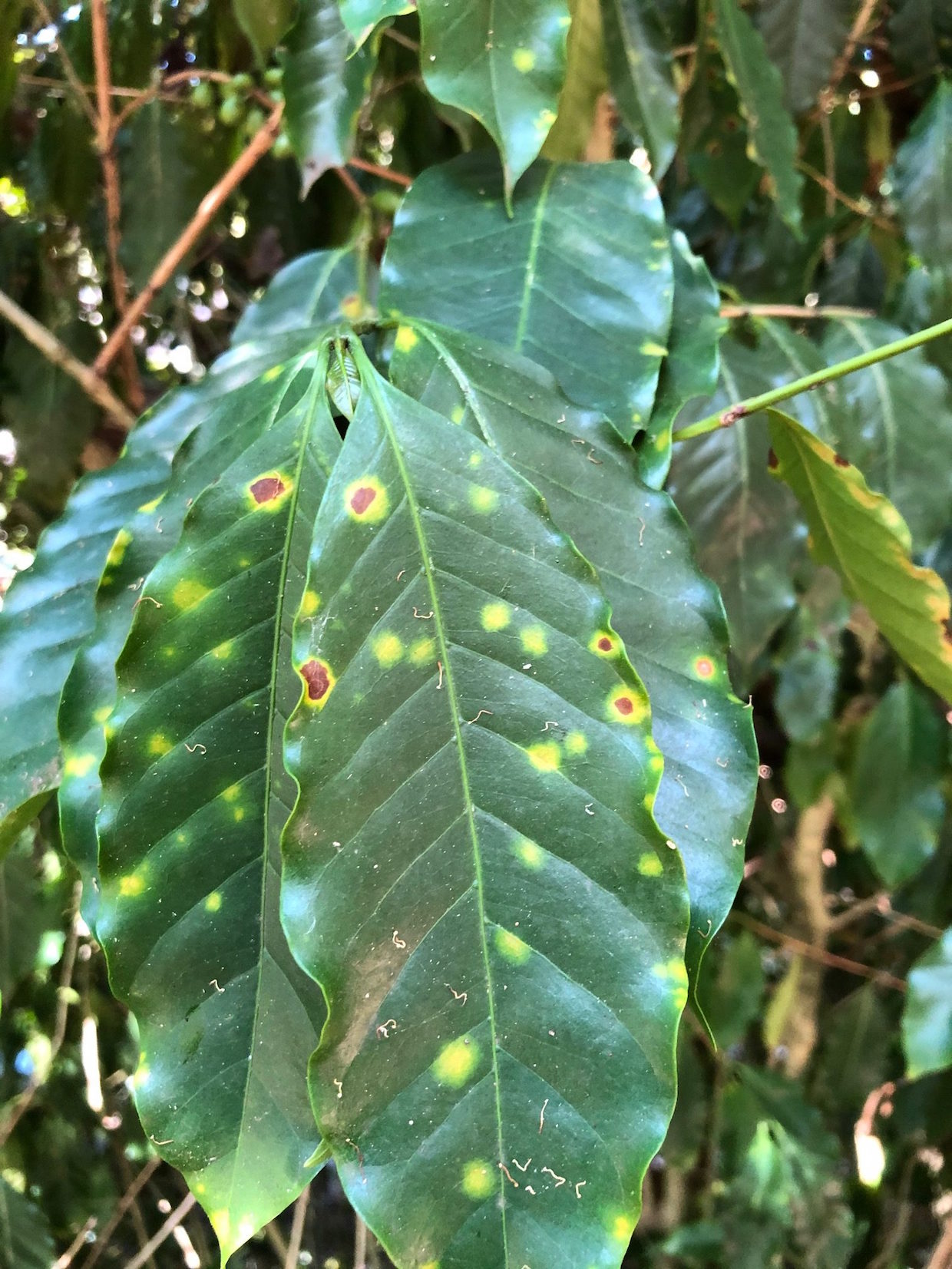
A coffee plant showing leaf rust spots on Hawaii Island. November 2020 press photo from the Hawaii Board of Agriculture.
The global fight against coffee leaf rust just got a major boost from the United States Department of Agriculture (USDA), which issued a four-year, $6 million grant for a coordinated research effort.
While the grant proposal and associated research are explicitly pitched for the benefit of the coffee sectors of Hawaii and Puerto Rico, researchers believe some of the work may ultimately benefit coffee producers all over the world in combating the disease.
A foe of the global coffee sector since the 1800s, coffee leaf rust is a fast-spreading, leaf-killing disease caused by the fungus Hemileia Vastatrix that typically results in crop losses of 70% or more on infected plots. After impairing coffeelands throughout Mexico, Central America and South America beginning in 2012 and causing often insurmountable losses to farmers, the disease was discovered in Hawaii for the first time last year.
Part of a $243 million package of freshly issued USDA grants to benefit the production of specialty crops in the U.S., the new leaf rust grant of just over $6 million was formally issued to the Synergistic Hawaii Agriculture Council (SHAC). It is heading towards a consortium of researchers at institutions including the USDA-ARS Tropical Agriculture Research Station (TARS) in Puerto Rico, the University of Hawaii, the University of Puerto Rico, Purdue University and Michigan State University.
Stated objectives for the coordinated research project, currently scheduled to run through September of 2025, include: 1) field trials of rust-resistant coffee varieties in Hawaii and Puerto Rico; 2) researching management options for existing coffee plants; 3) identifying fungicides or biological control methods; 4) economic analyses of U.S.-based coffee production; and genomic research designed to potentially benefit the global coffee industry.
Related Reading
- Popular Honduras Variety Lempira Found Susceptible to Leaf Rust
- Colombian Researchers Discover Aggressive New Variants of Coffee Leaf Rust
- Coffee Leaf Rust Discovered on All Major Islands of Hawaii
“It is incredible and important to see the U.S. stepping up investment for research on coffee’s most devastating disease,” Jennifer “Vern” Long, CEO of the nonprofit World Coffee Research, which is involved in some of the research projects, said in a press release yesterday. “This work will benefit not only Hawaiian and Puerto Rican growers, but will lead to insights and innovations that impact coffee farmers everywhere.”
The grant application notes that there are approximately 1,470 coffee farmers in Hawaii and 2,300 coffee farmers in Puerto Rico, where coffee leaf rust has been present since at least 1989.
Here’s more directly from the grant application:
Research from this grant will provide quantifiable benefits to the U.S. coffee industry and beyond, including a wide range of agronomic, economic, and genomic assistance. Benefits include field trials of new rust-resistant coffee tree varieties that meet the exacting standards of the high-value Hawaii industry and may increase the quality of coffee originating from Puerto Rico, thus raising the standard of living for growers.
Until the new varieties are ready for propagation, field research and extension will provide immediate solutions to maintain the tree health of current, susceptible varieties.Economic analyses will provide a deep look at US-grown coffee from both a growing and a selling perspective; this evaluation has not been done in the modern specialty coffee era.
Finally, analysis of CLR and coffee genomics will provide a closer look at a pathogen that is not yet understood on a genetic basis and identify the host/pathogen interaction that could lead to a better understanding of how the disease spreads and methods for how growers can control the fungus in their fields.
Nick Brown
Nick Brown is the editor of Daily Coffee News by Roast Magazine.
Comment
1 Comment
Comments are closed.






Vandermeer J, Perfecto I, Liere H. 2009. Evidence for hyperparasitism of coffee rust (Hemileia vastatrix) by the entomogenous fungus, Lecanicillium lecanii, through a complex ecological web. Plant Pathol. 58(4):636–641. [Crossref], [Web of Science ®], [Google Scholar]